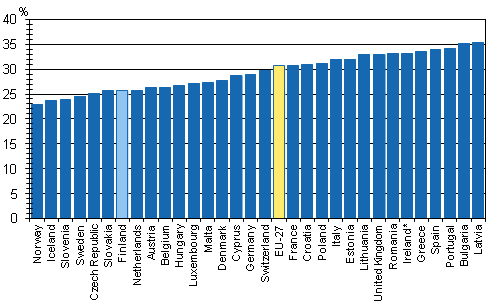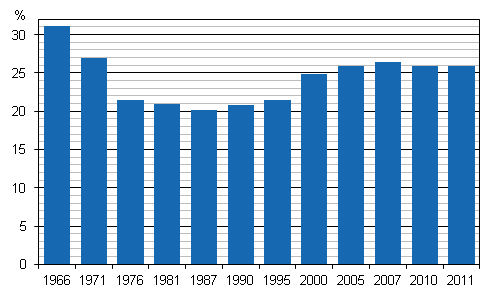Published: 22 May 2013
Income differentials in Finland still smaller than the European average
Income differentials in Finland are still smaller than the European average even though they grew relatively rapidly by international comparison in the late 1990s. In 2010, the smallest relative income differentials in Europe were found in Norway and Iceland and the largest in Latvia and Bulgaria. In Finland, the average income of the highest-income decile was 5.3-fold that of the lowest-income decile in 2010, while in the countries with the highest income differentials it was more than tenfold. These data derive from the results of the EU Statistics on Income and Living Conditions (EU-SILC), where Finland's data are based on Statistics Finland’s income distribution statistics.
The most common income inequality indicator, the Gini index, was 25.8 in Finland in 2010 when the average for European countries was 30.7. The Gini coefficient gets the value 0 if everyone receives the same amount of income and 100 if one income earner receives all the income. Income differentials are usually larger in eastern and southern European countries where the income level is also lower. Measured both by purchasing power adjusted income level and income differentials, Finland belongs to the group that contains mainly central and northern European countries. Income refers to the monetary income after taxes and consists of earned income, property income, and transfers.
Income inequality in the European countries 2010, Gini coefficient (%), equivalent disposable money income.

Source: Eurostat, EU Statistics on Income and Living Conditions (EU-SILC 2011, income reference period 2010). * Ireland 2009–2010.
In Finland, income differentials narrowed down from the mid-1960s to the 1980s. After this, the changes were small until the income differentials grew over a few years in the late 1990s close to their current levels. The Gini coefficient for disposable monetary income grew by 4.1 percentage points from 1990 to 2000 and by approximately one percentage point from 2000 to 2011. The figures are based on an internationally comparable income concept that does not include imputed income items or capital gains.
Income inequality in Finland 1966–2011, Gini index (%), equivalent disposable money income.

Source: Income Distribution Statistics (1987–2011), Household Budget Survey (1966–1981).
Source: Income Distribution Statistics 2011, Statistics Finland
Inquiries: Veli-Matti Törmälehto 09 1734 3680
Director in charge: Riitta Harala
- Tables
-
Tables in databases
Pick the data you need into tables, view the data as graphs, or download the data for your use.
Updated 22.5.2013
Official Statistics of Finland (OSF):
Income distribution statistics [e-publication].
ISSN=1799-1331. Income inequality (international comparison) 2011. Helsinki: Statistics Finland [referred: 19.4.2025].
Access method: http://stat.fi/til/tjt/2011/05/tjt_2011_05_2013-05-22_tie_001_en.html

